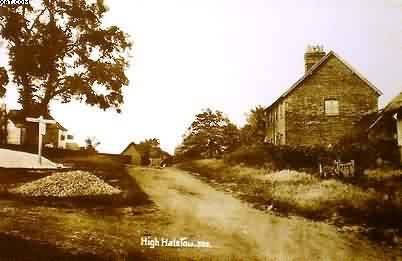High Halstow by Edward Hasted
1797 AD
NORTHWARD from Hoo lies Halstow, usually called High Halstow, as well from its high situation, as to distinguish it from another parish of the same name, near Upchurch, in this county. This place is written, in the Textus Rossensis, (fn. 1) Haglestow , and in other records, Aglestow .
IT LIES on high ground; the church, with Halstow street adjoining to it, is situated in the southern part of the parish, besides which there are several smaller hamlets, as Clinches-street, Fenn-street, &c. the northern part, being one half of the parish, is marshland, bounded by the river Thames; the hills cover the greatest part of it; the soil and the country is otherwise of the same sort as that of Hoo, last described, in every particular.

The ROYALTY of the manor or lordship of Hoo claims over this parish, and as such this place was antiently part of the possessions of the family of Bardolf; from which it passed in like manner to Poinz and Grey; and from them, in process of time, to Edward Villiers, esq. whose descendant, the Right Hon. George earl of Jersey, is the present possessor of it.
Reginald de Cobham was possessed of an estate in this parish, and in the 14th year of king Edward III. procured a charter of free warren in all his demesne lands in this parish of Halgesco.
John de Cobham, lord Cobham, gave an estate in this parish to the chantry of Cobham, founded by him. (fn. 2)
The prioress and convent of Dartford, and the college of All Saints, in Maidstone likewise possessed lands in this parish; part of the latter were the marshes of Eastwick and Spert, which by grant from the crown, came afterwards into the family of Somers, who possessed them in Charles II.'s reign. (fn. 3) This family, as appears by their pedigree, in the Heraldic Visitation of Kent, anno 1619, separated into two branches, one of which was of St. Margaret's, Rochester; and the other of this parish of Halstow. They bore for their arms, Vert, a fesse dancette ermine.
CHARITIES.
SIR JOHN CROMP gave, by will, in 1615, for poor widows, not receiving alms, a house and land, vested in the parish, of the annual produce of 8l.
RICHARD WHITE gave by will, in 1622, for the like purpose, land vested in John Prebble, of the annual produce of 1l. 10s.
RICHARD BAYLEY gave by will, in 1643, for the use of the poor, not receiving alms, land vested in Messrs. Cart, of the annual produce of 6s. 8d.
HALSTOW is within the ECCLESIASTICAL JURISDICTION of the diocese and deanry of Rochester. The church is dedicated to St. Margaret.
In the chancel are the following brafs plates: Two coats quarterly, 1ft, parted per fess indented; 2d, a chevron between three ewers or flower ports, and inscription, for William Palke, minister of High Halstow, obt. 1618, and Anne, his wife; two more for William Groby, rector, obt. 1398, and William, his father, obt. 1396. In the church yard, a tomb for William Somer, of this parish, gent. set up by William his son, in 1607, and repaired by Richard Somer, his grandson, gent. of Clifford's inn, in 1672.
This church was esteemed but as a chapel to the church of St. Warburgh Hoo, as appears by the instrument of bishop Laurence, in 1274, by which he confirms the antient payment of two marcs yearly to the said church; and for the greater security of it, he decreed, that the parson, who should in future be instituted in the said chapel by the prior and convent of Rochester, patrons of the said church, should, in the presence of him and his successors, swear to the due performance and payment of that pension. (fn. 4) The priory of Rochester continued in possession of this pension till the surrendry of it, into the hands of Henry VIII. in his 32d year, who the next year settled it, by his dotation charter, on his new founded dean and chapter of Rochester, who now possess it.
In 1476, John Mapulton, rector of Halstow, commenced a suit against Richard Fletcher, rector of St. Mary's, in the consistory court, before the bishop's official, for the recovery and establishment of his right to certain tithes, as rector of the parish of Halstow; viz. a moiety of all tithes, both great and small, in a district of land, called Le Meneparishe, the other moiety belonging to the rector of St. Mary's; and also of certain lands and tenements, called Eastwyke and Upwyke, as wholly situated within the parish of Halstow; and of a marsh, called Le Sperte, lying in Le Meneparishe, of which the rectors of this parish, his predecessors, were used to take a moiety of the tithes, the other moiety belonging to the rector of St. Mary's: all which were that year decreed to the rector of Halstow, by the definitive sentence of the official.
The rectory is valued in the king's books at 14l. 5s. 7d½. and the yearly tenths at 1l. 8s. 6¾d. (fn. 5)
In 1650, this rectory was valued at 100l. per ann. Sir Edward Hales being patron, and Mr. Benjamin Cromp, incumbent. In 1784, the value of this rectory was 295l. per annum, and the clear neat profit 230l.
The church of Halstow seems to have passed as an appendage to the manor of Hoo, through the several different owners of it, to Sir Edw. Hales, bart. who was patron of it in 1650. His son, Sir Edw. Hales, bart. alienated the patronage of it, which after some intermediate owners was conveyed to Chapman, whose heirs sold it to the Rev. Richard Fletcher; on whose death in 1763, it became the property of his son, the Rev. Richard Fletcher, who, in 1786, sold it to the Rev. Robert Burt, who died in 1788; and his widow, Mrs. Sarah Burt, is now entitled to it.
